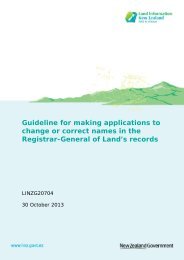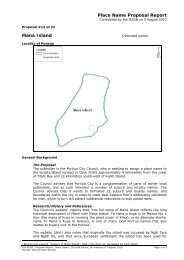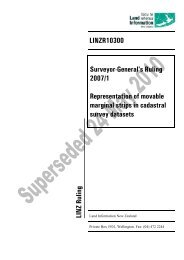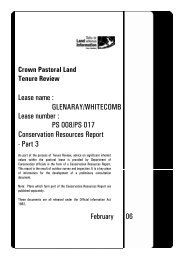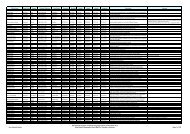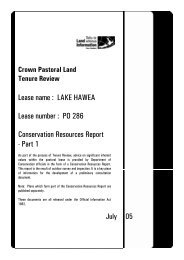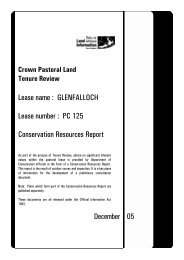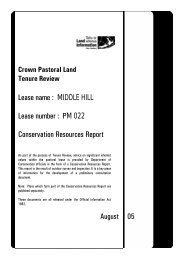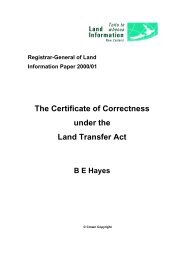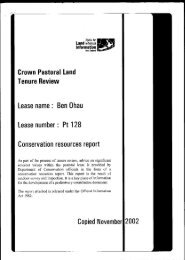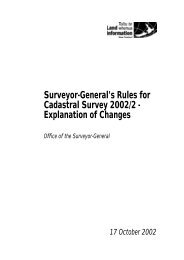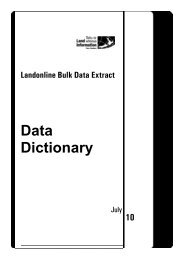Part 1 - Land Information New Zealand
Part 1 - Land Information New Zealand
Part 1 - Land Information New Zealand
You also want an ePaper? Increase the reach of your titles
YUMPU automatically turns print PDFs into web optimized ePapers that Google loves.
RELEASED UNDER THE OFFICIAL INFORMATION ACT<br />
2.7 Ecological Sustainability and Ecosystem Services<br />
<strong>Land</strong> Use Capability<br />
The <strong>Land</strong> Use Capability (LUC) system is a nationally consistent land classification system based<br />
on physical sustainability that has been used in <strong>New</strong> <strong>Zealand</strong> to help achieve sustainable land<br />
development and management since 1952. The LUC system has two key components. Firstly,<br />
<strong>Land</strong> Resource Inventory (LRI) is compiled as an assessment of physical factors considered to be<br />
critical for long-term land use and management. Secondly, the inventory is used for LUC<br />
classification, whereby land is categorised into eight classes according to its long-term capability<br />
to sustain one or more productive uses (Lynn et al. 2009).<br />
Analysis of LUC for the PL reveals that the land falls predominantly into two classes. <strong>Land</strong> at<br />
highest altitude (above c. 900 m but also extending down the Roaring Meg) is classified as class 7<br />
and that below as class 6. Class 7 land has severe physical limitations and consequently it is high<br />
risk land requiring active management to achieve sustainable production (Lynn et al. 2009). This<br />
class has a subclass ‘e’ which indicates that susceptibility to erosion is the main kind of physical<br />
limitation or hazard to use that has been identified. Class 6 land indicates low suitability for<br />
pastoral grazing or production forestry but with less severe limitations than class 7. This class also<br />
has a subclass ‘e’ indicating erosion limitations. The small area of easy terrain around the<br />
homestead and valley floor is class 3 indicating land of arable cropping suitability.<br />
Ecosystem Services<br />
Ecosystem services can be defined as “flows of materials, energy, and information from natural<br />
capital stocks, which combine with manufactured and human capital services to produce human<br />
welfare.” Constanza et al. (1997).<br />
The PL makes a significant contribution to providing ecosystem services (especially water<br />
harvesting) for the wider Otago region. Many people rely on these services as a basis for hydro<br />
electricity generation, irrigation, domestic consumption and for water-based outdoor recreational<br />
activities.<br />
There is a wealth of published hydrological information attained from studies on the Lammerlaw<br />
Range which quantify ecosystem services provided by tussocklands and wetlands. Research has<br />
been funded and conducted by several organisations including the Forest Research Institute (FRI),<br />
<strong>Land</strong>care Research (as the successor to FRI), University of Otago and the Otago Regional Council<br />
(ORC). Much of this information was obtained to assess the impacts of different land uses on<br />
water yield from uplands. Studies include: research on fog deposition in tall tussock grassland;<br />
hydrological effects of burning tall tussock; water yields from paired catchments under different<br />
land uses; snow hydrology; seasonal flow regimes; and water yield variability.<br />
Constanza et al. (1997) define ecosystem services as “flows of materials, energy, and information<br />
from natural capital stocks which combine with manufactured and human capital services to<br />
produce human welfare”; they identify 17 “services”. The PL contributes to eight of these<br />
services, excluding those of a recreation and cultural nature which are described elsewhere. These<br />
are outlined below.<br />
1. Gas Regulation:<br />
Much of the existing tussockland and shrubland has potential for further carbon sequestration. The<br />
full potential of subalpine and low alpine tussocklands to increase in density and stature and for<br />
18



